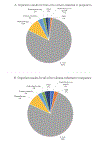Bad bugs: antibiotic-resistant bacteriuria in pregnancy and risk of pyelonephritis
- PMID: 34856419
- PMCID: PMC9785208
- DOI: 10.1016/j.ajogmf.2021.100540
Bad bugs: antibiotic-resistant bacteriuria in pregnancy and risk of pyelonephritis
Abstract
Background: The introduction of antibiotics has significantly reduced morbidity and mortality from microbial infections, but the rise of antibiotic-resistant and multidrug-resistant microbes is of increasing clinical concern. Few studies have examined the prevalence and impact of antibiotic resistance in common antenatal infections.
Objective: This study aimed to determine whether pregnant women with a urine culture positive for antibiotic-resistant or multidrug-resistant gram-negative bacteria are at increased risk of developing pyelonephritis than pregnant women infected with antibiotic-susceptible organisms.
Study design: This was a retrospective cohort study of pregnant women with asymptomatic bacteriuria or acute cystitis from a single health system from July 2013 to May 2019. Women with gram-negative antibiotic-resistant (resistance to 1-2 antibiotic classes) and multidrug-resistant (resistance to ≥3 antibiotic classes) lower urinary tract infections were compared with women with antibiotic-susceptible urinary tract infections in terms of demographic, infectious, antepartum, and intrapartum data. The primary outcome was pyelonephritis, defined as a billing code for pyelonephritis plus fever or flank pain. The secondary outcomes were length of stay in the hospital because of pyelonephritis, a composite of pyelonephritis complications (renal abscess, sepsis, and intensive care unit admission), and preterm delivery. The differences in the primary outcome were analyzed using multivariate logistic regression.
Results: A total of 573 women were eligible for inclusion. Of the 573 women, 334 (58%) had gram-negative bacteria on urine culture. Of the 334 cases, 173 (52%) were antibiotic susceptible, 74 (22%) were antibiotic resistant, and 87 (26%) were multidrug resistant. Women with antibiotic-resistant and multidrug-resistant infections were more likely to have hypertension (P=.004), to be Black (P=.03), to have public insurance (P=.002), and to experience more urinary infections (P=.001). Pyelonephritis was more common in women with antibiotic-resistant (adjusted odds ratio, 2.27; 95% confidence interval, 1.08-4.78) and multidrug-resistant (adjusted odds ratio, 3.06; 95% confidence interval, 1.57-5.96) infections than in women with antibiotic-susceptible urinary tract infections. Length of stay, preterm delivery, and pyelonephritis complications did not differ between antibiotic-susceptible and antibiotic-resistant and multidrug-resistant infections.
Conclusion: In an age of increasing antibiotic resistance, more than one-half of pregnant women with bacteriuria experience at least 1 infection with an antibiotic-resistant organism. These resistance patterns have a real clinical impact as pregnant women with antibiotic-resistant gram-negative lower urinary tract infections have an estimated 2- to 3-fold increased odds of developing pyelonephritis.
Keywords: Escherichia coli; gram-negative; multidrug-resistant bacteria; urinary tract infection.
Copyright © 2021 Elsevier Inc. All rights reserved.
Conflict of interest statement
Disclosures: The authors report no conflict of interest.
Figures
Similar articles
-
Urinary Tract Infection and Bacteriuria in Pregnancy.Urol Clin North Am. 2015 Nov;42(4):547-60. doi: 10.1016/j.ucl.2015.05.004. Epub 2015 Aug 1. Urol Clin North Am. 2015. PMID: 26475951 Review.
-
Lower Urinary Pathogens: Do More Pathogenic Bacteria Increase the Risk of Pyelonephritis?Am J Perinatol. 2022 Apr;39(5):473-478. doi: 10.1055/s-0040-1717093. Epub 2020 Sep 24. Am J Perinatol. 2022. PMID: 32971563
-
[Comparative effectivenesss of standard antibiotic therapy and Canephron N asymptomatic bacteriuria in pregnant women].Urologiia. 2018 Jul;(3):54-57. Urologiia. 2018. PMID: 30035419 Russian.
-
Urinary Tract Infections in Pregnant Individuals.Obstet Gynecol. 2023 Aug 1;142(2):435-445. doi: 10.1097/AOG.0000000000005269. Obstet Gynecol. 2023. PMID: 37473414
-
Urinary tract infections in pregnancy.Clin Microbiol Infect. 2023 Oct;29(10):1249-1253. doi: 10.1016/j.cmi.2022.08.015. Epub 2022 Aug 27. Clin Microbiol Infect. 2023. PMID: 36031053 Review.
Cited by
-
Pregnancy after repaired bladder exstrophy: a case report.Case Rep Womens Health. 2025 Jul 18;47:e00734. doi: 10.1016/j.crwh.2025.e00734. eCollection 2025 Oct. Case Rep Womens Health. 2025. PMID: 40735733 Free PMC article.
-
Host response during unresolved urinary tract infection alters female mammary tissue homeostasis through collagen deposition and TIMP1.Nat Commun. 2024 Apr 16;15(1):3282. doi: 10.1038/s41467-024-47462-7. Nat Commun. 2024. PMID: 38627380 Free PMC article.
-
Quantifying Health Outcome Disparity in Invasive Methicillin-Resistant Staphylococcus aureus Infection using Fairness Algorithms on Real-World Data.Pac Symp Biocomput. 2024;29:419-432. Pac Symp Biocomput. 2024. PMID: 38160296 Free PMC article.
-
Examination of Complementary Medicine for Treating Urinary Tract Infections Among Pregnant Women and Children.Front Pharmacol. 2022 Apr 27;13:883216. doi: 10.3389/fphar.2022.883216. eCollection 2022. Front Pharmacol. 2022. PMID: 35571128 Free PMC article. Review.
-
A review of antibiotic safety in pregnancy-2025 update.Pharmacotherapy. 2025 Apr;45(4):227-237. doi: 10.1002/phar.70010. Epub 2025 Mar 19. Pharmacotherapy. 2025. PMID: 40105039 Free PMC article. Review.
References
-
- Centers for Disease Control and Prevention. Antibiotic Resistance Threats in the United States, 2019. Atlanta, GA; 2019. doi:10.15620/cdc:82532 - DOI
-
- Antibiotic resistance. https://www.who.int/news-room/fact-sheets/detail/antibiotic-resistance. Accessed October 23, 2020.
Publication types
MeSH terms
Substances
Grants and funding
LinkOut - more resources
Full Text Sources
Medical
Research Materials



